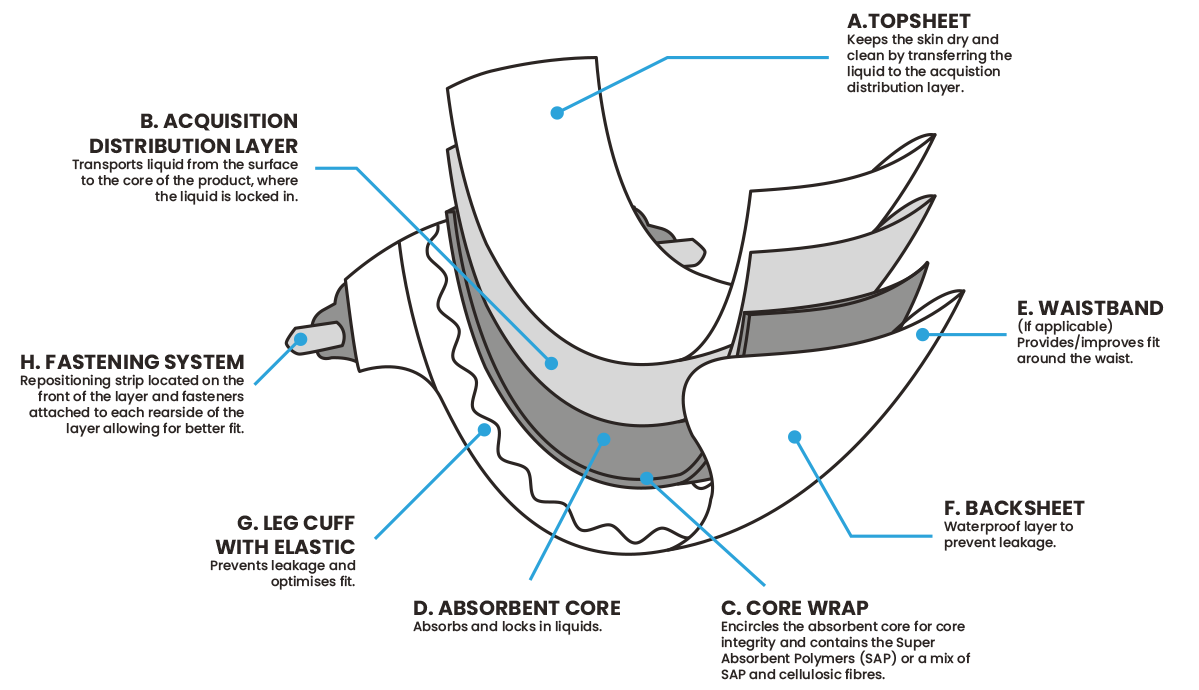Disposable Nappies
Disposable nappies started to become available to UK consumers in the 1950s. They came into mainstream use during the 1970s, offering a major advance in convenience and hygiene. They are quick, clean and easy to use and are the popular choice of around 95% of parents in the UK today.
Product innovation has focussed on improved design and fit, comfort, absorption, and environmental sustainability. The disposable nappies we use today are quite different from their early predecessors. Features which make them work so well include a one-way top sheet which wicks urine away from the skin to the core of the nappy where it is absorbed. The core of the nappy will contain absorbent materials which keep urine in the nappy. This helps to prevent nappy rash, as one of the causes of rash is prolonged skin contact with urine. It also helps to prevent urine mixing with the enzymes contained in faeces which is another contributing factor.
Click the image to enlarge
EXAMPLES OF MATERIAL COMPONENTS
A. TOPSHEET
Ultra thin cover made of cellulosic fibres, synthetic fibres or film of synthetic fibres
Polyester
Polyethylene
Polypropylene
Mixture of Polyethylene/Polypropylene
Viscose/Rayon
Cotton
B. ACQUISTION DISTRIBUTION LAYER
Porous material consisting of cellulosic or synthetic fibres or non wovens made up of synthetic polymers
Polyester
Polyethylene
Polypropylene
Viscose/Rayon
Cotton
C. CORE WRAP
Synthetic fibres or non wovens made from synthetic polymers or cellulosic fibres
Polyester
Polyethylene
Polypropylene
Viscose/Rayon
D. ABSORBENT CORE
Cellulosic and/or synthetic fibres without a Super Absorbent Polymer (SAP) or SAP without fibres
Cellulose/Pulp fibre
Cotton
Super Absorbent Polymer
E. WAISTBAND
Non wovens made of synthetic polymers
Polyester
Polyethylene
Polypropylene
Synthetic elastic
F. BACKSHEET
Film/non wovens made from synthetic polymers or cellulosic fibres
Polyethylene
Polypropylene
Cotton
Calcium Carbonate
G. LEG CUFF WITH ELASTIC
Non wovens made from synthetic polymers
Polyester
Polyethylene
Polypropylene
Synthetic elastic
Elastane
H. FASTENING SYSTEM
Synthetic polymers, adhesive
Polyester
Polyethylene
Polypropylene
Synthetic elastic
Thermoplastic polymers
There has been a great deal of interest in the environmental impact of nappies. Good environmental stewardship during manufacturing and reducing the environmental impact of products is very important to manufacturers. Technology and innovation have reduced the carbon impact of producing and using disposable nappies considerably.
For example, since the 1980s disposable nappies have become more than 50% lighter, due to the innovation of sophisticated new materials and design. In addition, sophisticated shrink-wrapping technology has made packs a fraction of their original size and allow usage of only a single layer wrapping, rather than boxes. This has resulted in a significant reduction in the use of raw materials, packaging, transportation, energy and fuel.
In 2008 the Environment Agency updated its 2005 Life Cycle Assessment of disposable and reusable nappies. Both studies concluded that while the two systems have differing impacts, i.e. disposable nappies add to waste, while reusable nappies consume water, electricity and detergents, they carry a similarly low level of impact on the environment.
In the UK, disposable nappies are produced according to the General Products Safety Directive (click to view)

Correct Disposal
Nappies should never be flushed down a toilet. Manufacturers’ on-pack disposal guidelines should be followed, and nappies should always be placed in a bin or appropriate disposal unit.
View
‘Nappy Rash: The Facts’, Dr Colin Michie
View
‘Caring For Baby’s Skin’ by Dr Sarah Brewer
Avoiding Nappy Rash
Avoiding nappy rash can be significantly helped by keeping baby’s skin clean and dry. Nappies should be changed regularly, and it is important to use the right size nappy as baby grows. Manufacturers’ guidelines for age and weight should be followed as these relate directly to a growing baby’s body and to the increasing amount of urine he will produce as he grows up.

